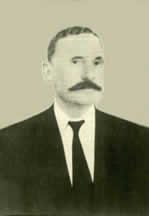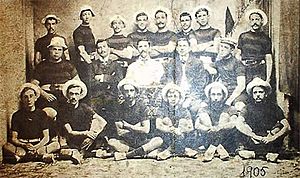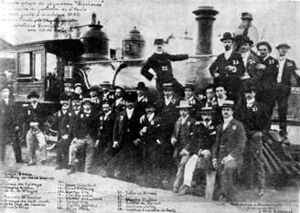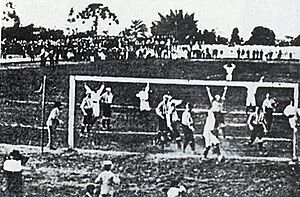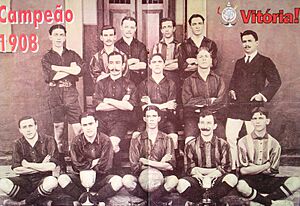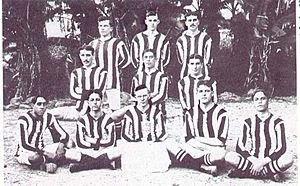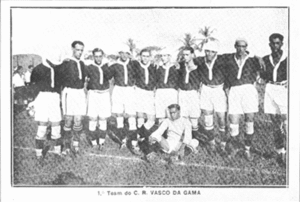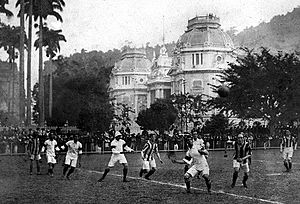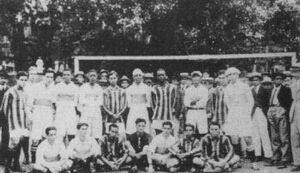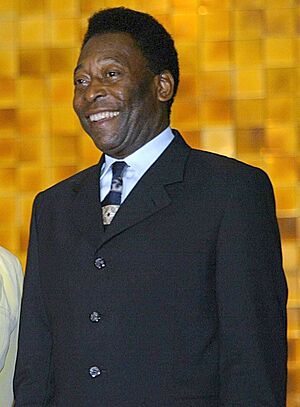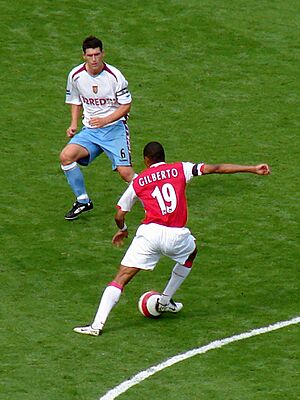History of football in Brazil facts for kids
The history of football in Brazil began in 1895, brought by the English, just like in many other countries. At first, only white, wealthy people played. The first football was reportedly brought in 1894 by Charles William Miller. However, some records show football was played earlier, in 1875 in Curitiba. For a long time, black people and poorer Brazilians could only watch. It wasn't until the 1920s that black players were accepted, especially after football became a professional sport in 1933.
Some clubs, mainly outside Rio de Janeiro and São Paulo, wanted to stay amateur. But over time, almost all of them became professional. Many traditional clubs either left the top football leagues or stopped playing the sport completely.
During the governments of leaders like Vargas, a big effort was made to promote football. The famous Maracanã Stadium was built, and Brazil hosted the World Cup in 1950 during Vargas's time. Brazil's victory in the 1958 World Cup, with stars like Didi, Pelé, Vavá, Garrincha, and captain Bellini, made football a huge part of Brazil's national identity. It brought together people of all backgrounds, colors, and regions.
Contents
- How Football Started
- First Championships and Clubs
- Brazil's National Team
- Early Criticisms of Football
- Becoming Popular and Professional
- After Amateurism Ended
- World Cups
- The Golden Age
- Brazilian Football During Military Rule
- CBD Becomes CBF
- 2000s: Players Go Abroad
- 2010-2020
- See also
- Images for kids
How Football Started
Charles William Miller, whose father worked for a railway company, is often called the "father of Brazilian football." Miller was born in Brazil but studied in England. There, he fell in love with football. In 1894, he returned to Brazil with two footballs in his suitcase.
He once shared a story about how it began:
On a cold afternoon in 1895, I gathered my friends to play football. The name was new to them, as they only knew cricket.
- "What is this game like?" some asked.
- "What ball will we play with?" others asked.
- "I have the ball. We just need to fill it up."
- "Fill it with what?" they asked.
- "With air."
- "Then go get it, and I'll fill it up."
This is how Charles Miller described the start of football in Brazil in a 1952 interview. The first friendly match, considered the first football game in the country, happened on April 14, 1895. It was played at Várzea do Carmo in São Paulo between English and Anglo-Brazilian employees of the São Paulo Gaz Company and the São Paulo Railway Company. The São Paulo Railway team won 4-2.
Other Ideas on Football's Start
Some records suggest football was played in Brazil even earlier. In 1874, foreign sailors played a match on the beaches of Rio de Janeiro. In 1878, sailors from the ship Criméia played a game for Princess Isabel. Also, in 1886, Anchieta College in Nova Friburgo regularly played football, influenced by Jesuit priests.
The idea that Miller was the first is also challenged by Bangu Atlético Clube. They say a Scotsman named Thomas Donohoe introduced the sport. Thomas, a technician from England, came to help set up a factory in Bangu. In 1894, he supposedly brought a ball from England and started the first Brazilian football game in May 1894, four months before Miller. Historian Loris Baena Cunha also found records of a match in Pará in 1890, played by English employees of various companies.
Other unconfirmed stories exist too. Some say a man named Mr. Hugh introduced football in Jundiaí in 1882. Others say that between 1875 and 1876, employees from two companies played a match at Paissandu Atlético Clube in Rio de Janeiro. However, the story about Charles Miller is the most widely accepted.
Soon after its introduction, football spread to other states. In 1897, student Oscar Cox brought football to Rio de Janeiro after returning from Switzerland. In 1901, he created the Rio Team, the state's first team. In Rio Grande do Sul, Johannes Minerman and Richard Woelckers founded the Sport Club Rio Grande in 1900. In Bahia, José Ferreira Filho, known as Zuza Ferreira, introduced the sport in 1901 after studying in England. In 1903, Guilherme de Aquino Fonseca, after studying in England, returned to Pernambuco and founded the Sport Club do Recife in 1905. Vito Serpa brought the sport to Minas Gerais in 1904, and Charles Miller Wright to Paraná in 1908.
First Championships and Clubs
The São Paulo Athletic Club was Brazil's first football team, formed in 1894 by Charles Miller. The Associação Atlética Mackenzie College, from 1898, was the first team for Brazilians. The first club made only for football was the São Paulo Sport Club Internacional, founded in 1899, but it no longer exists. Later that same year, the Sport Club Germânia was founded by German Hans Nobiling. Today, it's called Esporte Clube Pinheiros.
Because Germânia's football section closed, Sport Club Rio Grande, in Rio Grande, is considered the oldest active football club in Brazil. In 1976, to honor this club, the former CBD (now CBF) made July 19th, the club's founding date, "Football Day." After Sport Club Rio Grande, Associação Atlética Ponte Preta (AAPP) from Campinas, São Paulo, is the next oldest active club, founded on August 11, 1900.
In 1901, the first match between teams from São Paulo (paulistas) and Rio de Janeiro (cariocas) took place. This rivalry became famous with the creation of the Torneio Rio–São Paulo in 1933. Oscar Cox, excited about his Rio Team (which would become Fluminense Football Club), talked with others about a match between paulistas and cariocas. The first game was on October 19th at the São Paulo Athletic Club field and ended in a 1-1 draw. The next day, another match ended 2-2.
On December 19th of the same year, the Liga Paulista de Football was founded. In 1902, the Campeonato Paulista de Futebol, Brazil's first official championship, was held. The São Paulo Athletic Club won. Gradually, new clubs appeared in the state of São Paulo, like SC Americano, AA São Bento, SC Internacional, Ypiranga, and Paulistano.
In Bahia, the state football league started in 1905. The Liga Bahiana de Sports Terrestres had four founding clubs. Only Victoria, now Esporte Clube Vitória, founded in 1899, is still active today.
In Rio de Janeiro, Fluminense was founded on July 21, 1902. It was the first football club in the state and helped create a state league. From 1904, new clubs emerged, including Botafogo Football Club and America. In 1906, the first Campeonato Carioca was held, and Fluminense was champion. On May 30, 1909, Botafogo set a record for the biggest score in Brazilian football history, beating Sport Club Mangueira 24-0 in the Campeonato Carioca. The top scorer, Gilbert Hime, scored nine goals.
Between 1910 and 1919, more teams and federations appeared, and the sport became even more popular. In 1910, after Corinthian FC from London visited Brazil, the current Sport Club Corinthians Paulista was founded in São Paulo. Two years later, Santos Futebol Clube was founded. In 1912, Clube de Regatas do Flamengo started playing football, and Club de Regatas Vasco da Gama followed in 1915. Both clubs had existed since the 19th century but started with rowing.
At first, only white people could play football professionally in Brazil because most early clubs were founded by foreigners. There's a famous story about a mixed-race player named Carlos Alberto. In a 1914 match, he covered himself with rice powder to appear white. But as he sweated, the powder washed off. Fans of his old club, America, recognized him and shouted "rice powder!" This nickname was then used by Fluminense fans, who started throwing rice and talcum powder when their team entered the field.
Regional championships grew, and the public and press became very interested, spreading football across the country. Football separated from tennis and cricket, which were elite sports. It became popular with everyone, especially in the 1920s, when black players started to be accepted by more clubs. Vasco was one of the first big clubs to win titles with a team full of black and poorer players.
Brazil's National Team
When the Brazilian Sports Federation (FBS) was founded in 1914, the Brazilian national team played its first unofficial game against the British team of Exeter City. The game was held at Fluminense Football Club's Laranjeiras Stadium in Rio de Janeiro, and Brazil won 2-0. Brazil's first title came two months later when they beat the Argentine team 1-0 in Buenos Aires and won the Roca Cup.
Early Criticisms of Football
Even though football became Brazil's favorite sport by the 1920s, not everyone liked it at first. Some intellectuals, like writer Graciliano Ramos, thought football showed European superiority over Brazilians. He even joked that real Brazilian sports were things like arm wrestling and foot races.
Writer Lima Barreto was a strong critic. He believed football caused disagreements and that clubs were run by descendants of slave owners. He even tried to ban the sport in Brazil, saying it caused fights and deaths. While football was never banned, there were discussions about limiting it. In 1916, the Academia Nacional de Medicina considered banning the game for children under 18. In 1919, it was stopped at the Pedro II College in Rio de Janeiro.
The working class also didn't welcome the sport at first. Union leaders, many of whom were anarchists or communists, thought football was a way for factory owners to distract workers from their cause. They saw it as a "consumerist and alienating" tool of the wealthy.
However, this view began to change in the 1910s. Union leaders realized they could use sport to attract members. Events were organized where workers' teams played matches, which also helped spread labor ideas. Years later, the Workers' Festival of 1919 was created, featuring friendly matches between worker teams.
Becoming Popular and Professional
The 1920s were a key time for football to become truly popular in Brazil. A great example was the final of the South American Football Championship (now Copa América) on May 29, 1919. Brazil's team played Uruguay, and it was the first time Brazil had gone so far in the tournament. The excitement was so huge that the president, Delfim Moreira, gave public workers the day off. Shops in Rio de Janeiro closed. Even in other states, the match felt very patriotic.
This popularity led to a debate between amateur and professional football. The first signs of paid players came from workers' football. Factory owners realized that successful teams named after their factories were great for promoting their products. Workers who played well started getting benefits, like prizes for wins, time off for training, and easier jobs. This was the start of "worker-players." Writer Mário Filho described how good players at the Bangu factory got "lighter work" and even office jobs with better pay.
The "worker-player" idea gave workers a second income and a chance to improve their social standing within the factory. Playing football became a way to move up in life. Famous player Domingos da Guia said he started football more out of need than desire, because of the money he received after each victory.
A New Era Begins
In 1923, professional football really started with Vasco da Gama. Vasco had created a football department in 1915 and, like some other clubs from the suburbs, gathered players who were poor, had little education, or were unemployed. This worried the wealthy elite in Rio de Janeiro. For the upper class, football was just for fun, without any money involved. They believed it was their right to play, with rules made for them. So, including players who played for money, not just fun, seemed like a threat to their way of thinking. The entry of poorer classes into football was seen as a danger to the elite clubs of the South Zone of Rio de Janeiro.
However, this "threat" wasn't seriously fought at first because clubs with poorer players usually played in lower divisions. For a while, football in Rio was split: the main division was amateur, while lower divisions were semi-professional, sometimes called "brown professionalism."
This changed in 1923 when Vasco moved up to the first division of the Campeonato Carioca de Futebol. Vasco's team was a mix of suburban players: a taxi driver, a dockworker, a wall painter, a truck driver (all black), and four white players who couldn't read or write. Despite doubts, Vasco had a great first round, winning six games and drawing one out of seven. They continued their good performance and won the Campeonato Carioca. Vasco's victory was a big deal because it showed that people without high social status could succeed in a sport previously limited to the wealthy. Mário Filho wrote that the advantage of being from a good family, being a student, or being white had disappeared. Everyone had to compete equally. This was a true revolution in Brazilian football.
The "big clubs" were upset and tried to stop professionalism in the Liga Metropolitana de Desportos Terrestres (LMDT). They accused the LMDT of being too "popular" for supporting smaller clubs. The South Zone teams demanded changes to the league's rules, like giving more voting power to clubs like América, Botafogo, Flamengo, and Fluminense. Most other teams didn't agree, which led to a split in Rio de Janeiro football. The big clubs and some others left the LMDT and founded the Associação Metropolitana de Esportes Athleticos (AMEA) on March 1, 1924. The new league's rules clearly excluded unemployed people, those who couldn't read or write, and anyone who earned a living from manual labor.
However, amateur football couldn't last long, both in Brazil and worldwide. In 1923, in Italy, Juventus paid for a player's transfer, which set a new example for teams to buy players. Many other countries, like Spain, Austria, Argentina, and Uruguay, adopted professionalism from 1924 onwards. This spread led FIFA to allow paid athletes to play in the first World Cup in 1930.
In Brazil, the situation also became difficult for amateurism. In 1932, a group of players wrote in a newspaper, asking for the right to be professional football players. In 1933, player Floriano Peixoto Correa wrote a book criticizing amateurism. He said that "hidden professionalism" was growing, with clubs secretly paying players bonuses while keeping most of the money for themselves.
Players like Amilcar Barbuy also spoke out. He said he was tired of being an amateur when clubs were getting rich, and he was getting nothing. He decided to move to Italy, where players were paid for their skills.
Club managers also wanted professionalism. They were unhappy with the "brown amateurism" system, which was neither fully amateur nor fully professional. They believed professionalism could make the sport a better show and, most importantly, keep the best players on their teams.
Without paying salaries, Brazilian amateur clubs couldn't compete with foreign clubs, which offered good money to talented athletes. For example, Fausto dos Santos moved to Barcelona, Spain, in 1931.
The government of Getúlio Vargas in 1930 also pushed for the end of amateur practices. Vargas's government wanted to create a stronger Brazilian identity and citizenship. To do this, he regulated many parts of society, including sports, making them more organized and centralized.
So, in 1933, the presidents of Vasco, Fluminense, América, and Bangu left the AMEA and founded the Liga Carioca de Football (LCF). This was the first group to officially accept professional athletes.
In August of the same year, the Associação Paulista de Esportes Atléticos (APEA) did the same. Both groups left the CBD and created the Federação Brasileira de Football (FBF), which supported professionalism and got FIFA's permission to represent Brazil in international games.
As professionalism grew, the CBD became its main opponent. The frequent disagreements between the CBD and the FBF led to Brazil sending only amateur players to the 1934 World Cup, which resulted in the team being disqualified. However, in 1937, the CBD finally accepted professionalism to keep its power over national football. This marked the end of amateur football in Brazil.
After Amateurism Ended
The Copa América, first called the South American Football Championship, started in 1916 for national teams. From its first edition until 1949, Brazil won only three times out of 21 tournaments. Still, many historians say Brazil's amazing victory over Uruguay in the final of the 1919 South American Championship, held at the Fluminense stadium (built for the event), started Brazil's deep love for football. Brazil won with a goal by Friedenreich in extra time. He was carried on fans' shoulders, and his boots were displayed in a jewelry store. Opponents even nicknamed him "El Tigre." This match was also important for Brazilian music; Pixinguinha composed the famous song "1x0" inspired by it.
Professional football meant some great teams in state tournaments disappeared. But it also opened the way for new football geniuses to emerge, following "El Tigre." These included Fausto dos Santos, Domingos da Guia, Leônidas da Silva, Waldemar de Brito, Zizinho, and Pelé.
World Cups
The World Cups began in 1930, and the Brazilian National Team has played in every one. After weak performances in the first two World Cups, Brazil hosted the tournament in 1950, after a break due to World War II.
The "Maracanazo" and Its Effects
In 1950, Brazil hosted the World Cup, and everyone expected them to win their first title. However, in the final, the Brazilian team lost 2-1 to Uruguay, who won their second title. This shocking defeat led to big changes in Brazilian football. For example, the national team's uniform changed from white to yellow, blue, white, and green. This event is known as the "Maracanazo" and is one of football's biggest upsets.
To help the country recover from the loss, journalist Mario Filho brought back the Torneio Rio–São Paulo. This tournament, played regularly by top teams from Rio and São Paulo, later helped create a national championship. Soon after, the Copa Rio Internacional tournaments were held in 1951 and 1952, won by Palmeiras and Fluminense.
The Golden Age
From the late 1950s, Brazilian football produced many amazing players. Pelé, Garrincha, Nílton Santos, Didi, Vavá, Zagallo, Djalma Santos, and captain Bellini were some of the stars who helped Brazil win the 1958 World Cup. Many of these players also played in the 1962 World Cup winning team, joined by new talents like Amarildo, Coutinho, and Pepe.
In 1959, the CBD decided to create a new competition for clubs to replace an older one. It was called Taça Brasil, the country's first national tournament. It was created to find the Brazilian champion club that would play in the Copa Libertadores, which at the time only featured national champions. The first champion was Bahia. But it was Santos, with Pelé, who won the Taça Brasil the most times (five in a row). Santos and Botafogo, with Garrincha, became major rivals in Brazil and even internationally. In 1962, Santos was the first Brazilian club to win the Libertadores and the Intercontinental Cup.
Brazilian football's success led many Argentine teams to hire Brazilian coaches in the 1960s. Vicente Feola coached Boca Juniors in 1961, and Osvaldo Brandão coached Club Atlético Independiente in 1961 and 1967, winning a national championship. Tim coached Boca Juniors to a national championship in 1968.
Even though Brazil didn't do well in the 1966 World Cup, in 1970, the Brazilian team won the competition for the third time. They received the Jules Rimet Cup (a trophy that was later stolen) for being the first country to win the World Cup three times.
In 1967, the Torneio Roberto Gomes Pedrosa ("Robertão") was created as a new national championship, allowing more clubs to participate. This competition quickly became recognized as the national championship. The Torneio Rio-São Paulo and Taça Brasil were stopped, and the "Robertão" decided the Brazilian champions until 1970.
Brazilian Football During Military Rule
In 1971, the CBD started a new tournament, the Campeonato Nacional de Clubes. This championship grew a lot, from 20 clubs to 94 participants in 1979. This expansion helped integrate football more across the country.
Between 1972 and 1984, only clubs from São Paulo, Rio de Janeiro, and Rio Grande do Sul won the tournament. These included Palmeiras (champions in 1972 and 1973) and Internacional (champions in 1975, 1976, and 1979). Guarani won in 1978, becoming the first club from outside a state capital to win the title. This dominance was broken when Coritiba won in 1985.
Brazilian clubs slowly became more familiar with the continental championship, the Copa Libertadores. Cruzeiro was the second Brazilian team to win it in 1976. Flamengo won in 1981, and Grêmio in 1983. Both Flamengo and Grêmio also won the Intercontinental Cup in those years.
In 1974, the Brazilian national team finished fourth in the World Cup. In 1978, the Brazilian national team finished third at the FIFA World Cup. Brazil called itself the "moral champion" because they were the only undefeated team.
CBD Becomes CBF
In 1979, the Brazilian Sports Confederation (CBD) changed its name to Brazilian Football Confederation (CBF). This happened because FIFA said that all national football organizations should focus only on football. The CBD used to promote other Olympic sports.
Giulite Coutinho was the president of the CBF from 1980 to 1986. During his time, the Granja Comary training center was built. In the 1982 World Cup, the team led by Telê Santana, with stars like Zico, Falcão, Sócrates, and Júnior, was expected to win but was eliminated in the quarter-finals by Italy.
In 1987, the CBF said it had financial problems and suggested a regionalized Brazilian championship. This led to the creation of the Clube dos 13. The idea for the Copa União with 16 clubs was first rejected by the CBF. In 1988, Ricardo Teixeira was elected as the new CBF president.
Soon after, Teixeira and the new CBF director, Eurico Miranda, introduced a new Brazilian football calendar. With the Copa União in 1987, many clubs from less popular regions, who joined the Campeonato Brasileiro by being state champions, no longer played against the "big ones." This put them at risk of going bankrupt. So, the federations pushed for a new competition, leading to the creation of the Copa do Brasil in 1989.
In 1989, Brazil won its first Copa America title since 1949. In the 1994 World Cup, the Brazilian team, led by Romário, finally won the World Cup again. It was their fourth title, a record at the time. In 1998, Brazil reached the final again but lost 3-0 to France.
In the second half of the 1990s, Brazilian teams won the Copa Libertadores four times: Grêmio in 1995, and then Cruzeiro, Vasco, and Palmeiras from 1997 to 1999. However, none of them won the world title. In 1999, the Copa CONMEBOL became a third-tier competition, replaced by the Copa Mercosur, which Palmeiras, Flamengo, and Vasco won in its early years.
At the end of the 1996 Campeonato Brasileiro, Fluminense and Bragantino were set to be moved down to a lower division. In 1997, a TV news program released phone call recordings that suggested a scheme within the CBF. Because of these claims, the CBF canceled the relegation that year. In the courts, the case didn't go forward because the recordings were considered illegal evidence.
2000s: Players Go Abroad
In the 2000s, many Brazilian football players started leaving to play for European clubs. Brazilian clubs became weaker and lost control over their players' contracts. Each year, more Brazilian footballers went to play professionally in other countries with stronger economies. In 2008, about 800 players left Brazil to play abroad. In 2007, 1085 players moved in international transfers.
The year 2000 began with the 2000 Club World Championship in Rio and São Paulo. Corinthians won, beating Vasco in the final at the Maracanã stadium.
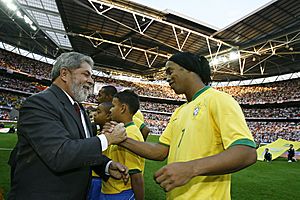
In 2002, the Brazilian national team went to the World Cup after a difficult preparation. However, led by Ronaldo, Rivaldo, and Ronaldinho Gaúcho, among others, Brazil won its fifth world title.
In the same year, the Copa Sudamericana replaced the Copa Mercosur. Brazil joined this new continental competition in 2003. So far, only Internacional and São Paulo have won it.
In 1999, a player for São Paulo, Sandro Hiroshi, was reported to have played when he shouldn't have. Teams like Botafogo and Internacional went to court and got points from their games against São Paulo. Gama, who would not have been moved down to a lower division if São Paulo's original results stood, went to court against the CBF. This made the 2000 championship uncertain. An agreement was reached, and the Copa João Havelange was played in 2000, bringing together 116 clubs.
In 2003, the Campeonato Brasileiro changed to a new format where all teams played each other twice. This change affected the sport's calendar, ending some regional competitions and shortening state ones. São Paulo FC won the tournament three times under this new format, becoming the most successful team in this "straight points era" by the end of the decade.
The Club World Cup got a new format in 2005, including winning teams from all continental competitions. The first editions (2005 to 2008) were played in Japan. São Paulo and Internacional won the first two years, and Corinthians won the tournament in 2012.
In 2005, the "Mafia do Apito" scandal happened. Some people had "negotiated" with a referee to make sure certain game results happened, on which they had bet money. Another referee was also involved. Eleven games in the Campeonato Brasileiro that this referee worked on were cancelled and replayed. That year, Corinthians won the championship. If the original results had stayed, Internacional would have been the champion.
The Brazilian national football team was eliminated twice in a row in the quarter-finals of the FIFA World Cup in 2006 and 2010. Brazil was a favorite in both tournaments because of their good results between World Cups, winning the 2004 and 2007 Copa América and the 2005 and 2009 FIFA Confederations Cup.
2010-2020
On October 30, 2007, FIFA officially announced Brazil as the host of the 2014 FIFA World Cup. Organizers first thought it would cost about US$1.1 billion, but it ended up costing around US$3.6 billion for stadium work. A survey two months before the tournament showed that only 48% of Brazilians supported the event, a big drop from 79% in 2008. About 55% thought the event would do more harm than good. Several protests happened in Brazil against the 2014 FIFA World Cup.
The Brazilian national football team won the 2013 FIFA Confederations Cup and was a favorite to win the World Cup at home. However, they finished fourth, losing 7-1 to Germany in the semi-final in a match known as the "Mineiraço." This result was seen as a national embarrassment for Brazil. In 2018, the national team was eliminated in the World Cup quarter-finals. During this period, the team won three Olympic medals: silver in 2012 and gold in 2016 (their first ever) and in 2020.
However, stadiums in Brazil became more expensive and exclusive after the 2014 World Cup changes. Ticket prices went up a lot. This changed who could afford to go to games regularly. It also changed many cultural traditions of Brazilian and South American football.
One big change was replacing the traditional standing areas with regular seats, which used to be only in special sections. While the old standing areas sometimes had safety problems due to lack of maintenance, many fans loved watching their team up close for affordable prices.
In 2013, the Bom Senso F.C. movement started, created by players from major Brazilian football clubs. They demanded better conditions in Brazilian football. The movement gathered over 300 signatures from players and asked for five main things from the CBF: a better national football calendar, proper player vacations, enough pre-season time, fair financial rules, and player involvement in football decisions. The movement ended in 2016.
Also in 2013, in the last game of the Campeonato Brasileiro, Portuguesa played a midfielder who had been suspended two days earlier. This meant the club lost points and was moved down to Série B in 2014, which helped Fluminense stay up. This kind of situation, where decisions about suspended players are changed, became known as "tapetão."
Over the decade, three CBF presidents faced issues. Ricardo Teixeira, who led the organization from 1989 to 2012, resigned from the CBF. His successor, José Maria Marin, was arrested in Switzerland. In 2014, Marco Polo Del Nero took over CBF but was later removed from football activities.

See also
- Brazil at the FIFA World Cup
- Blind football
- CP football
- Seven-a-side football
- Beach soccer
- Football Museum
- Football in Brazil
Images for kids


